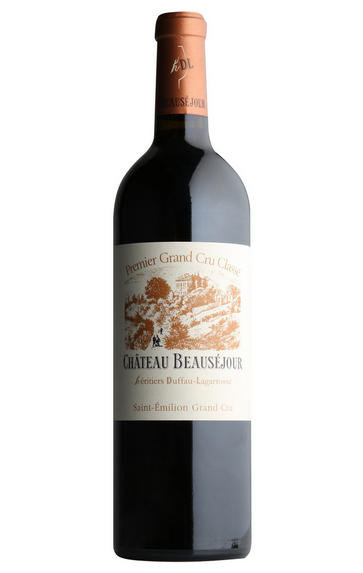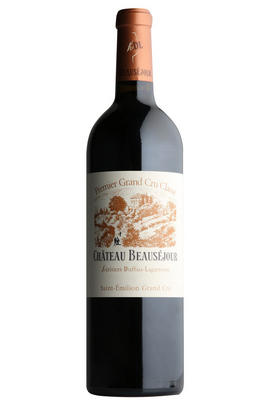
2015 Château Beauséjour Duffau-Lagarrosse, St Emilion, Bordeaux

Critics reviews
Drink 2025-2055
Antonio Galloni, Vinous (Feb 2018)
Drink 2025-2040
Jancis Robinson MW, jancisrobinson.com (Jan 2019)
Drink 2022-2033
Decanter (Mar 2020)
About this WINE

Château Beauséjour
Château Beauséjour is a 6.8-hectare jewel long recognised for the quality of its terroir; it has been a Premier Grand Cru Classé B since the first St Émilion classification. Almost half the vineyard sits atop the appellation’s limestone plateau, another half extends down onto the côtes. This was once part of a larger estate along with what is now Château Beau-Séjour Bécot.
In 2020, the estate was put up for sale. There were many bidders; the French authorities were called upon to oversee the final decision. Ultimately, members of the Duffau-Lagarrosse family bid successfully, in tandem with the owners of the Clarins beauty group.
The estate is today led by Joséphine Duffau-Lagarrosse and Prisca Courtin-Clarins, both of whom are in their early 30s. They took the reins with the 2021 vintage, following the acclaimed stewardship of Nicolas Thienpont and his team.

St Émilion
St Émilion is one of Bordeaux's largest producing appellations, producing more wine than Listrac, Moulis, St Estèphe, Pauillac, St Julien and Margaux put together. St Emilion has been producing wine for longer than the Médoc but its lack of accessibility to Bordeaux's port and market-restricted exports to mainland Europe meant the region initially did not enjoy the commercial success that funded the great châteaux of the Left Bank.
St Émilion itself is the prettiest of Bordeaux's wine towns, perched on top of the steep limestone slopes upon which many of the region's finest vineyards are situated. However, more than half of the appellation's vineyards lie on the plain between the town and the Dordogne River on sandy, alluvial soils with a sprinkling of gravel.
Further diversity is added by a small, complex gravel bed to the north-east of the region on the border with Pomerol. Atypically for St Émilion, this allows Cabernet Franc and, to a lesser extent, Cabernet Sauvignon to prosper and defines the personality of the great wines such as Ch. Cheval Blanc.
In the early 1990s there was an explosion of experimentation and evolution, leading to the rise of the garagistes, producers of deeply-concentrated wines made in very small quantities and offered at high prices. The appellation is also surrounded by four satellite appellations, Montagne, Lussac, Puisseguin and St. Georges, which enjoy a family similarity but not the complexity of the best wines.
St Émilion was first officially classified in 1954, and is the most meritocratic classification system in Bordeaux, as it is regularly amended. The most recent revision of the classification was in 2012

Merlot
The most widely planted grape in Bordeaux and a grape that has been on a relentless expansion drive throughout the world in the last decade. Merlot is adaptable to most soils and is relatively simple to cultivate. It is a vigorous naturally high yielding grape that requires savage pruning - over-cropped Merlot-based wines are dilute and bland. It is also vital to pick at optimum ripeness as Merlot can quickly lose its varietal characteristics if harvested overripe.
In St.Emilion and Pomerol it withstands the moist clay rich soils far better than Cabernet grapes, and at it best produces opulently rich, plummy clarets with succulent fruitcake-like nuances. Le Pin, Pétrus and Clinet are examples of hedonistically rich Merlot wines at their very best. It also plays a key supporting role in filling out the middle palate of the Cabernet-dominated wines of the Médoc and Graves.
Merlot is now grown in virtually all wine growing countries and is particularly successful in California, Chile and Northern Italy.


Buying options
Add to wishlist
Description
One of the undisputed stars of the vintage, the 2015 Beauséjour Héritiers Duffau-Lagarrosse is dark, brooding and explosive to its core. The essence of super-ripe dark cherry, plum, graphite, crushed rocks, gravel, smoke and incense infuses a dramatic, sweeping Saint-Émilion endowed with superb power and intensity. Sumptuous, spectacularly rich and also massively structured, the 2015 is going to need at least a decade to come into its own. Those lucky enough to find it are in for a treat, as the 2015 is a total stunner. Nicolas Thienpont and his team hit a number of home runs in 2015, including at Beauséjour Héritiers Duffau-Lagarrosse, where both wines are simply great. Tasted two times with consistent notes.
Drink 2025-2055
Antonio Galloni, Vinous (Feb 2018)
wine at a glance
Delivery and quality guarantee